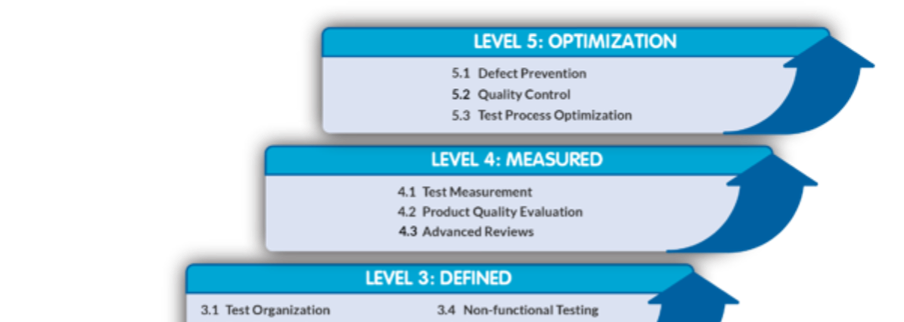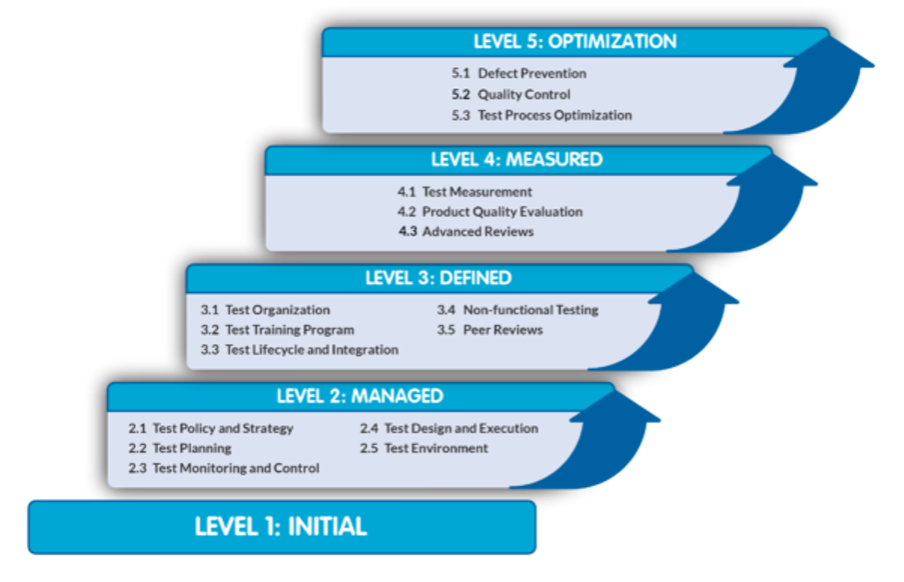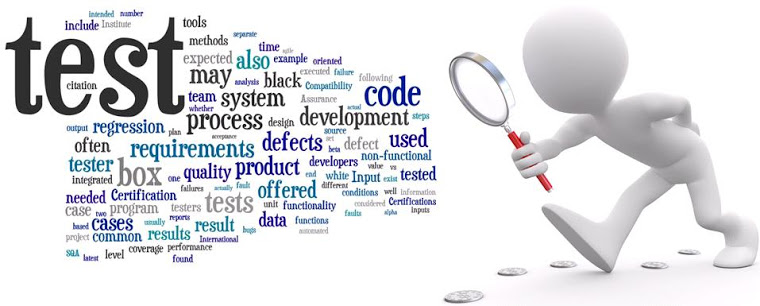This is the third and final part in our series on the TMMi (Test Maturity Model Integration) framework. In parts one and two, we examined TMMi Level 2 and Level 3 in depth. Today, we will take a look at the final two levels of the TMMi Framework—Level 4 “Measured” and Level 5 “Optimisation”.

The Role of TMMi in Advancing Software Testing at Levels 4 & 5
At Levels 4 and 5, TMMi goes beyond traditional software testing practices, integrating advanced measurement techniques and optimisation strategies. This integration improves software performance and ensures high quality with minimal defects. These levels emphasise proactive quality management and continuous process improvement so they align closely with broader business objectives.
- Strategic Alignment: TMMi integrates testing processes with strategic business goals, emphasising the importance of testing in achieving organisational objectives.
- Advanced Metrics and Measurement: These levels prioritise using sophisticated metrics to enhance testing efficiency and gain insights into process effectiveness and product quality.
- Optimisation and Automation: TMMi encourages the adoption of optimisation techniques and automation to improve process efficiency.
- Risk Management: With a focus on sophisticated testing strategies, TMMi helps manage and mitigate risks, directly contributing to project and product success.
- Innovative Practices: TMMi promotes the adoption of innovative testing methodologies and technologies to stay updated with technological advancements.
By emphasising these areas, TMMi at Levels 4 and 5 plays a crucial role in advancing software testing through strategic integration, advanced metrics, process optimisation, risk management, and innovation. It ensures that testing processes contribute significantly to overall business success.
Understanding Levels 4 & 5
Level 4 within the TMMi framework covers areas like Focus on Test Measurement, Product Quality Evaluation, and Advanced Reviews. These aspects introduce more advanced methods for measuring and evaluating test processes and product quality, which in turn enhance the effectiveness of review practices. This level aims for a deeper understanding and control over the testing process through precise measurement, enabling better decisions regarding product quality and enhancing the effectiveness of peer reviews.
The TMMi 2nd World-Wide User Survey conducted in 2023 gathered insights from a diverse range of organisations spanning various sectors, including Banking, Healthcare, and IT Software Delivery. The findings revealed tangible benefits derived from the implementation of Levels 4 and 5:
- Greater customer satisfaction evidenced by overwhelmingly positive feedback.
- Substantial reductions in defect leakage rates surpassing 50% in some cases.
- Noteworthy improvements in test efficiency including up to a 30% enhancement in effective test cycle time.
- Attained exceptional stability in the test environment with reliability now reaching 99.76% in some cases.
- Strengthened testing discipline and capability leading to better performance and reliability.
Moving on to Level 5, it focuses on Defect Prevention, Quality Control, and Test Process Optimisation. This level emphasises preventive measures for quality, comprehensive quality control strategies, and continuous optimisation of testing processes. It significantly reduces defect rates, ensures consistent quality control throughout the development lifecycle, and promotes ongoing improvement of testing processes for efficiency and adaptability.
The insights from the TMMi World Wide User Survey report also align with the principles of higher maturity levels in testing, with key recommendations including:
- Significant Enhancement in Defect Detection: Organisations have observed substantial improvements in their ability to detect defects early in the development cycle, leading to enhanced software quality and reliability.
- Notable Reduction in Defect Leakage: By emphasising quality control and defect prevention strategies, projects have reported up to a 50% decrease in defect leakage to production, illustrating the effectiveness of rigorous quality assurance practices.
- Advancements in Test Process Efficiency: The implementation of TMMi Level 5 practices has significantly improved the discipline and capability within testing teams. This focus on optimisation and continuous improvement has led to more robust and efficient testing processes, elevating the overall quality of software projects.
- Elevated Testing Discipline and Capability: Implementing TMMi Level 5 practices has fostered a culture of continuous improvement and excellence in testing disciplines, significantly uplifting the overall testing capability within organisations.
Progressing to TMMi Levels 4 and 5 signifies a notable evolution in the maturity of software testing practices. It goes beyond basic improvements to embrace optimisation and ongoing improvement. These levels prioritise measurement, evaluation, and process enhancement to ensure that testing practices not only fulfil present requirements but also remain adaptable to future demands.

In-Depth View Per Process Area
Level 4
Test Measurement
Developing a strong test measurement program holds significant importance for organisations to objectively assess the efficiency and effectiveness of testing processes, leading to improved decision-making and resource allocation.
- According to findings from the TMMi User Survey, a leading Banking institution introduced a thorough test measurement initiative and, in doing so, saw a significant reduction of over 50% in its defect leakage rate. This underscores the importance of emphasising test measurement practices and the positive outcomes they can generate for organisations.
Nonetheless, grappling with the complexities of integrating measurement tools into existing workflows and ensuring the pertinence and precision of measurement criteria poses considerable challenges.
Product Quality Evaluation
Systematic evaluation of product quality throughout the development lifecycle is important as it allows for proactive quality management, reducing the risk of post-release defects.
- The TMMi User Survey found that one Banking institute saw the Defect Detection Rate for its A-Level system reach 99.7%, meaning that almost all defects within this system were identified before reaching production. This enhancement underscores the significant impact that focused quality assessment practices can have on identifying and resolving defects more efficiently in software development, ultimately leading to improved product quality, customer satisfaction, and business success.
However, striking a balance between the depth of quality assessments and the demands of project schedules and budget constraints presents a significant challenge.
Advanced Reviews
Implementing advanced review techniques can be beneficial for identifying and addressing defects early in the development lifecycle, leading to cost savings and improved product quality.
- According to the User Survey, a Banking software provider achieved a 10% increase in test efficiency by implementing advanced Review Techniques. This gain was largely attributed to the early detection and resolution of issues, underscoring the critical role that comprehensive review sessions play in enhancing testing workflows. These advanced reviews improved efficiency and contributed to the project’s overall success by ensuring higher-quality outputs and optimising resource allocation.
However, it can be challenging to ensure that all team members are trained in these techniques and integrate them into the workflow without causing delays. It requires a concerted effort to promote continuous learning and adaptation within the team, which may be difficult for some companies due to time and skill constraints.
Level 5
A focus on defect prevention through root cause analysis leads to a significant reduction in the introduction of defects, streamlining the development process and improving product quality.
- By implementing advanced defect prevention measures, one Financial software provider included in the TMMi User Survey achieved a remarkable 50% reduction in defect leakage to production. This significant improvement highlights the efficacy of rigorous review and testing strategies in improving software quality. Such advancements not only improve the reliability and safety of Financial software but also play a crucial role in minimising patient care risks, thereby elevating the standard of outcomes.
However, creating a culture prioritising defect prevention and investing in root cause analysis can be challenging, requiring organisational commitment and mindset change.
Quality Control
Comprehensive quality control strategies ensure that quality is maintained throughout the entire development process, from initial requirements to final release, leading to more reliable and stable products.
- The TMMi User Survey found that, after revamping its quality control processes, a Finance platform realised a 30% improvement in test efficiency, specifically in the effective test cycle time. This enhancement directly translated into a more streamlined testing process, significantly reducing the time required to identify and resolve defects. Such efficiency gains not only bolster the quality of the software but also contribute to a more agile development cycle, enabling faster response to customer needs and improving overall satisfaction.
However, integrating comprehensive quality control requires significant coordination across different teams and stages of the development lifecycle.
Test Process Optimisation
Continuous improvement of test processes through innovation and adoption of new technologies means that testing remains effective and efficient in the face of changing requirements and technologies.
- A mobile Finance application developer included in the User Survey improved test efficiency by 20% by adopting test process optimisation practices, including automation and AI-driven testing. This advancement significantly improved their ability to quickly and effectively test new features and updates, contributing to a more agile and responsive development cycle. As a result, the developer could meet market demands more promptly, giving them a greater competitive edge and driving greater profitability through improved operational efficiency.
However, balancing the investment in new technologies and methods with the need to maintain current operations can be challenging, requiring careful planning and resource allocation.

Achieving TMMi Levels 4 and 5 with Experimentus
Reaching TMMi Levels 4 and 5 brings about profound changes, empowering organisations to improve their testing processes and reconcile them closely with business goals and technological progress to achieve greater efficiency, agility, and innovation in their operations. This journey demands a dedication to ongoing enhancement, an openness to embracing transformations, and an emphasis on quality throughout the development journey.
However, navigating this journey alone can be challenging. Experimentus stands ready to provide invaluable support throughout this challenge. With our expertise in advanced software testing and process integration, we are a trusted partner for enterprises moving towards TMMi Levels 4 and 5. Our profound understanding of the intricacies allows us to adeptly guide organisations through the complexities of higher-level testing processes, ensuring a seamless and successful transition.
If you would like to learn more, get in touch with our team today. We would be more than happy to discuss it with you and help you on your journey to achieving TMMi Levels 4 & 5.


Leave a Reply